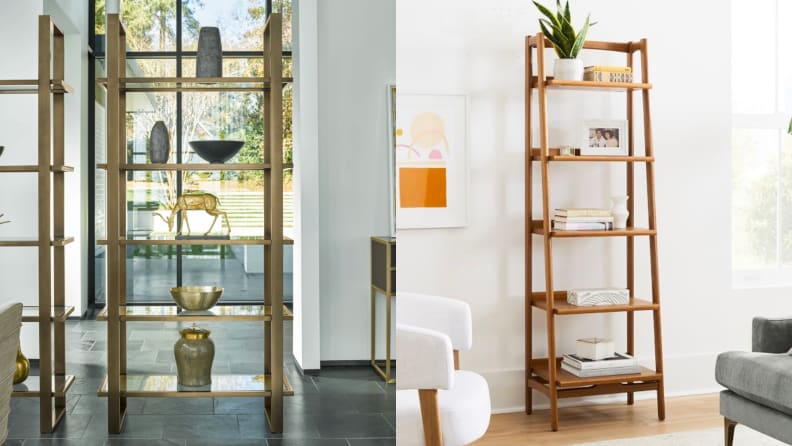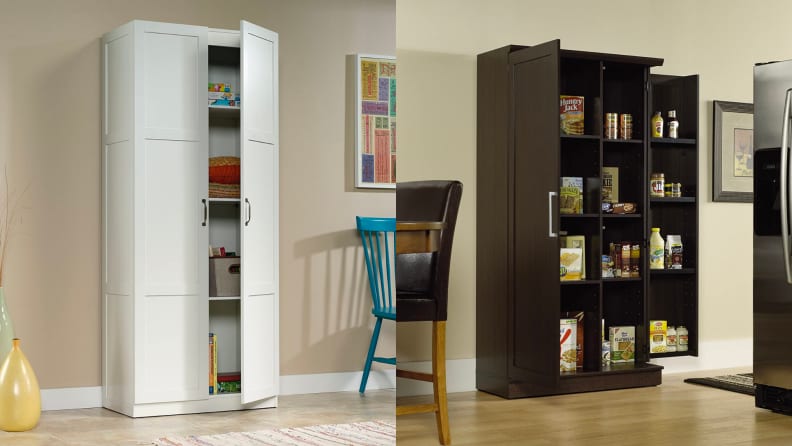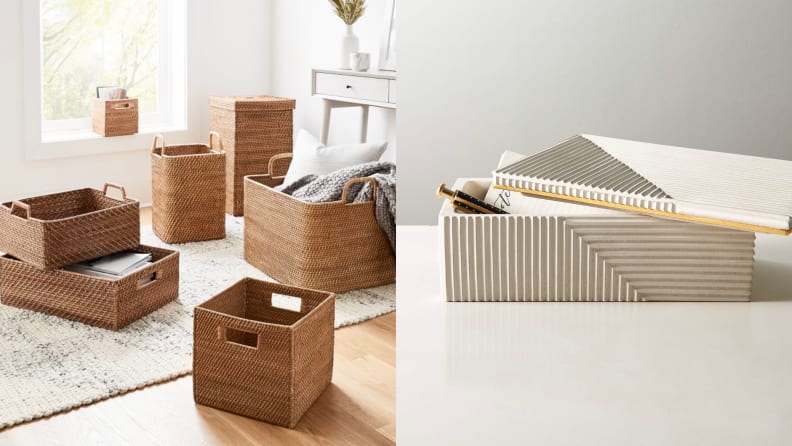Here’s how to up your storage game—literally
Tall furniture offers options for organization
 Credit:
Wayfair / West Elm / Sauder
Credit:
Wayfair / West Elm / Sauder
Products are chosen independently by our editors. Purchases made through our links may earn us a commission.
Shelving, bookcases, tall desks, and decorative ladders have arguably never been more important for storing, stacking, and organizing, as droves of Americans have come home to work and learn in the last two years. With many children and adults sharing rooms, furnishings with function are key.
Consequently, the less space items take up in a room—and the more these pieces can accommodate—the better. Versatile shelving and drawers in all aspects of the house, from kitchen to living spaces to bedrooms and closets, can help keep homes organized, tidy, and accessible.
Pay attention to skinny and tall designs

These open-backed bookshelves are great for a minimalistic look.
In the forefront of product designers’ minds today is how to make home goods that work for ever-changing and challenged lifestyles.
The beauty of slender shelving designs—like narrow storage cabinets, floating-shelf bookcases, wardrobe racks with shelves, and coat trees with shelves—is that they are more likely to fit in anywhere.
Etageres tend to fit really tight spaces, but also deliver in terms of what they can house. Coast to Coast Accents, a furniture manufacturer based in Memphis, Tennessee, has a plethora of choices, from woodsy and whimsical to funky stair-stepper looks.
Pat Bowling, vice president of communications at American Home Furnishings Alliance, says, “The mid-century modern etagere from Coast to Coast illustrates the common asymmetrical design theme for etageres right now.”
Universal Furniture features the Asher utility cabinet dressed up with a Shaker design and equipped with plenty of behind-closed-doors organization options, as well as the Justeene corner cabinet, which brings an old look back to life.
Bowling says, “This [corner cabinet] not only makes productive use of an otherwise empty corner, it employs that space more than seven feet up! That’s the kind of ‘tall order’ today’s furniture designers have no trouble meeting.”
- Get the Universal Furniture Etagere Bookcase at Perigold for $2,025
- Get the Mid-century Bookshelf at West Elm from $549
- Get the Helix Walnut Bookcase at CB2 for $279
- Get the Stretto Entryway Cabinet at Crate & Barrel for $699
- Get the Colton Shelf Storage Cabinet at Wayfair for $249.99
Optimize organization

These Sauder cabinets can work as pantries or linen storage.
In order to optimize storage, current pieces are providing spaces in every nook and cranny to keep books, office supplies, recipes, photographs, papers, craft items, napkin rings, spices, dog toys, candles—you name it.
Because of their narrow nature, slim-styled furnishings can take up space all along a back wall, in a corner, flanking a sofa or wood stove, in hallways, in a large bathroom, in a spacious kitchen or keeping room, in open dining areas, dens, and great rooms. In fact, these organizational wonders are ideal throughout a home.
Space considerations, functionality, and organizational capabilities “are important aspects in the design. We have double deep storage pieces to increase the capacity and organizational capabilities,” says Joe Ruedinger, principal design director at Sauder Woodworking Company in Archibold, Ohio. “We try to put as much functionality as we can afford to add in each piece.”
Sometimes storage space is even added inside a door.
Ruedinger further points out, “[Consumers] definitely want tall storage pieces for many rooms in a house, and they are buying open storage to display their stuff and closed storage pieces to hide their stuff.”
- Get the Sauder Storage Cabinet at Amazon for $169.99
- Get the Sauder HomePlus Collection Storage Cabinet at Amazon for $252.85
Don’t overlook style for storage

Boxes can be stylish and handy.
While practicality is the name of the game when it comes to filling vertical spaces, aesthetics are important as well. Interiors can be equipped with attractive baskets, boxes, and vases, even though the shelves might be behind closed doors.
But, when open shelving is the vertical space to work with, decorators provide plenty of tips to make them serve their purposes while also looking good.
Driven by Décor founder Kris Jarrett, based in Connecticut, recommends leaning, rather than stacking, books. She also loves to position small, thin accessories next to a framed print and larger accessories, such as a sculpture, alongside a horizontal stack of books or a printed or carved box, which can also serve as a spot for storing paper clips, thumb drives, music pics, extra keys, remotes, and more.
Accessories also work as bookends; a special, large seashell, a favorite bowl, or a planter works double duty to embellish shelving and secure books.
Decorators often suggest starting from the top when it comes to organizing and adorning vertical storage, keeping in mind that the highest spots are for lesser used items and midway to low-level areas are for commonly used items. Not over-cluttering is key so that needed items are not difficult to find.
The overall goal is to utilize as much vertical furnishings’ space for necessities, those items needed daily or at least often, and then fill in nooks and crannies with bits of meaningful, whimsical, and even frivolous extras.
- Get the Modern Weave Rattan Baskets at West Elm from $30
- Get the Home Expressions Woven Storage Basket Collection at JC Penney from $18
- Get the Chelsea Cement Box at CB2 for $34.95
- Get the Hand-carved Rosewood Jewelry Box at Amazon for $14.35
The product experts at Reviewed have all your shopping needs covered. Follow Reviewed on Facebook, Twitter, Instagram, TikTok, or Flipboard for the latest deals, product reviews, and more.
Prices were accurate at the time this article was published but may change over time.


